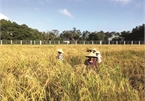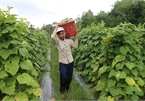 |
| Shrimp – rice farming fields in Ben Tre Province’s Thanh Phu District. – VNA/VNS Photo Cong Tri |
The delta, the country’s largest rice and seafood producer, is normally affected by saltwater intrusion from the sea via river mouths in coastal areas in the dry season. Farmers cannot grow rice in most coastal areas in the dry season, but the shrimp – rice farming model can be used in these areas.
Farmers use fresh water, mostly rainwater, to grow rice in the rainy season, and let saltwater enter the rice fields to breed shrimp in the same rice field during the dry season.
The delta has more than 220,700ha of shrimp – rice farming areas, with Kien Giang Province accounting for 102,486ha, the largest area, according to provincial departments of agriculture and rural development.
In Kien Giang, the shrimp – rice farming area increased from 12,300ha in 2000 to 60,000ha in 2010 and to 102,486ha at present.
Le Van Dung, head of the Kien Giang Agriculture Extension Centre’s Information and Technology Transfer Division, said that Kien Giang in recent years has turned thousands of hectares of rice farming areas into shrimp – rice farming areas.
Shrimp – rice farming is seen as a smart farming model and is zoned for sustainable development. “The centre provides cultivation techniques to farmers,” he said.
Shrimp – rice farming is environmentally friendly as farmers use few chemicals. After each shrimp crop cultivation, the residue of shrimp waste and organisms becomes fertiliser for field soil. After each rice crop cultivation, shrimp have few diseases because disease pathogens are destroyed during rice cultivation.
In Ben Tre Province, shrimp – rice farming in coastal areas has increased farmers' incomes two to three times higher than from growing only rice.
Phan Van Chi, who farms shimp and rice in his 8,000sq.m field in Ben Tre’s Thanh Phu District, said his income has increased two times compared to rice farming only. He earns a profit of more than VND100 million (US$4,400) a year.
Thanh Phu District set up the Thanh Phu Rice – Shrimp Co-operative that helps guarantee outlets for the co-operative’s members.
Dao Cong Thuong, chairman of the Thanh Phu People’s Committee, said the model is sustainable and efficient. It offers an average profit of VND70 – 80 million ($3,000 – 3,500) per hectare a year and is adapted to climate change.
The district is encouraging farmers to expand the areas of shrimp – rice farming and offer tourism services related to the model.
Ben Tre has about 2,500ha of shrimp – rice farming areas and has potential to expand to 15,000ha, according to the province’s Agriculture Extension Centre.
In Bac Lieu Province, farmers have 39,000ha of shrimp – rice this year. Of the number, nearly 10,000ha are planted with ST24 and ST25, two of the world’s best rice varieties in 2019, according to the province’s Department of Agriculture and Rural Development.
Local authorities in Bac Lieu have urged farmers to grow more ST24 and ST25 varieties to develop the province’s brand names for fragrant rice and clean shrimp.
Le Van Tinh, who began growing ST24 rice variety in Bac Lieu’s Hong Ngu District this year, said many local farmers switched to ST24 and ST25 rice varieties this year after local authorities gave farmers rice seeds and instruction in farming techniques on how to grow the varieties.
Last year Bac Lieu set up three model shrimp – rice farming areas with a combined area of 150ha for intercropping clean rice and shrimp.
Luu Hoang Ly, director of the Bac Lieu Department of Agriculture and Rural Development, said the province would expand the shrimp – rice farming area to more than 43,000ha in 2025.
To reach the target, the department is providing techniques for farmers to produce rice in large quantities to meet market demand at home and abroad, and increase value. The department will also act as a link between farmers and rice companies to secure outlets for farmers.
Infrastructure
Local authorities in the delta’s provinces are seeking capital to build irrigation projects for shrimp – rice farming areas to improve efficiency since most localities in the delta have imperfect irrigation systems.
Most farmers in coastal areas raising shrimp and cultivating rice on the same fields still depend on rainwater.
Kien Giang Province’s Vinh Thuan District has 10,000ha of shrimp – rice fields but farmers still depend on natural weather conditions for their rice and shrimp cultivation.
Vo Hoang Nguyen, head of the Vinh Thuan Bureau of Agriculture and Rural Development, said the district’s irrigation system is imperfect and the supply of fresh water still depends on rainwater.
Ca Mau Province has about 36,00ha of shrimp – rice farming areas this year but most of the areas have weak irrigation systems, according to the province’s Irrigation Sub-department.
Nguyen Long Hoai, head of the sub-department, said that since most canals in shrimp - rice farming areas are open canals, saltwater enters the rice fields, damaging the crop, when hot weather and drought occurs early.
In Bac Lieu Province, Gia Rai Town has spent nearly VND50 billion ($2.2 million) to build an irrigation system for shrimp – rice farming.
The National Agriculture Extension Centre has given VND4 billion ($174,000) to Bac Lieu to develop the model.
Last month, the Ministry of Agriculture and Rural Development began operation of the first phase of the Cai Lon – Cai Be irrigation system, the delta’s largest, on a trial basis.
The Cai Lon – Cai Be irrigation system is expected to serve a total area of 384,120ha of agriculture and aquaculture in Ca Mau, Bac Lieu, Soc Trang, Hau Giang and Kien Giang provinces in the delta.
Source: Vietnam News

Seasonal organic rice revival in Mekong Delta
According to the analysis by QY Research published in 2020, the total value of global organic rice exports in 2018 was US$1.5 billion.

Mekong Delta farmers switch to other crops in response to climate change
More farmers in the Mekong Delta have restructured their crop cultivation to adapt to the effects of climate change.